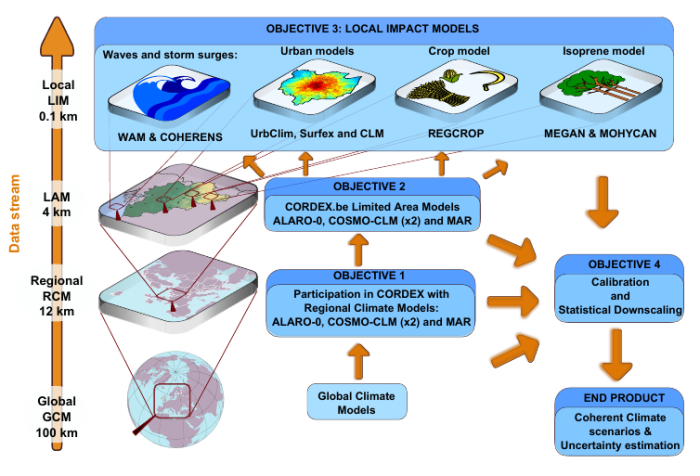CORDEX.be framework
According to the Global Framework for Climate Services (GFCS) there are four pillars required to build climate services (Hewitt et al., 2012):
- observations and monitoring;
- research, modelling and projection;
- climate services information system and;
- a user interface platform.
CORDEX.be focuses on point 2. by data-driven capacity development and community building in Belgium based on interactions with users. The overall and long-term target is to provide standardized and coherent information to the stakeholder community concerning climate-change information for Belgium. The GFCS also distinguishes the global, regional and national levels of climate services and emphasizes the interactions among the different levels. Our national effort will link to the regional climate initiatives through the contribution of high-resolution climate simulations over Europe.
Climate change is of strong international interest so it is of major importance to place the national initiative in an international context. The most important international setting is governed by the Intergovernmental Panel on Climate Change (IPCC) in their Fifth Assessment Report (AR5, Stocker et al., 2014). It describes the so-called Representative Concentration Pathways (RCPs) for atmospheric greenhouse gases, which are based on a set of General Circulation Model (GCM) runs that are collected in the Coupled Model Intercomparison Project Phase 5 (CMIP5, Taylor et al., 2012). CORDEX is an international project that goes beyond the CMIP5 baseline by modeling the regional climate (Giorgi et al., 2009; Jacob et al., 2014) and providing detailed prescriptions for Regional Climate Models (RCMs) and their data exchange. Due to the coherence, such collection does not only enable to estimate future climate change projections but also provide uncertainties. Analogously to CMIP5 and CORDEX, and based on the existing Belgian expertise, CORDEX.be provides a prototype framework that goes beyond CORDEX to close the gap between regional climate runs and “local”-impact assessment for climate services. More specifically, CORDEX.be will investigate the local impacts of climate change on:
- urban effects;
- storm surges and waves;
- crop production and;
- changes in emissions from vegetation.
Hence, the climate services from such a local-impact assessment are necessary to help stakeholders and the general public to understand the more technical aspects. Therefore CORDEX.be provides the first step to turn climate science into practice in Belgium.
Performing High-Resolution (H-Res) model simulations is crucial for impact studies. GCM runs are essential to estimate for instance the future time point of 2°C global warming, but the direct impact on society may not be clear from such large scale GCMs runs. Climate change is felt in extreme weather events (e.g. extreme storms, floodings, heat waves, droughts, urban-heat island effect) which depend on influences of small spatial scale. However, such small-scale processes can only be captured by models of high spatial resolution, quantified by the spacing between points on a model grid. GCM models typically feature resolutions of 100-200 km, while the highest CORDEX-prescribed RCM resolutions are 12.5 km, Limited Area Models (LAMs) run at resolutions of 4 km, and finally, Local-Impact Models (LIMs) may have resolutions of 1 km and below. Such H-Res runs are performed on limited geographical domains, with meteorological conditions at the boundaries imposed by model simulations at lower resolution. Therefore LAM runs critically depend on the availability of RCM runs which in turn depend on GCM runs, and, all must be consistent among one another. Therefore local climate impact assessment relies on the presence of a coherent model hierarchy and a coordinated framework. The stepwise process towards high resolutions is called downscaling and is illustrated in the figure below.

Methodologically “CORDEX and beyond” is based on two cornerstones:
- downscaling and;
- the multi-model approach.
Due to the dependence structure imposed by the downscaling procedure, this aspect naturally determines the data stream, the timing of the project and the structure and interactions within the network. The multi-model approach, on the other hand, allows for an uncertainty estimation, a crucial aspect of climate projections for policy-making purposes. Akin to the approach of CMIP5 and CORDEX, the aim here is to pool all available resources, both nationally and internationally. This is necessary given the limited availability of H-Res runs.
It is shown that, for the successful production of actionable science and usable climate services, the iteration between knowledge producers and users is critical (Dilling and Lemos, 2011). Within CORDEX.be such two-way interaction is of utmost importance and already present at the level of modelers. The downscaling approach is, by definition, a top-down approach where “top” and “down” represent global models and user-oriented H-Res models, respectively (Brasseur and Gallardo, 2016). Nevertheless, the CORDEX.be guidelines are bottom-up for a number of reasons. The enormous model complexity of GCM, RCM and LAM models combined with the lengthy integration time of large climate simulations constrain the data that can be stored from each run. Therefore, prior to performing such runs, a rigorous selection must be made concerning the data that must be kept and for this reason the CORDEX.be guidelines are “bottom-up” of nature.
